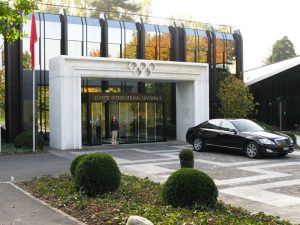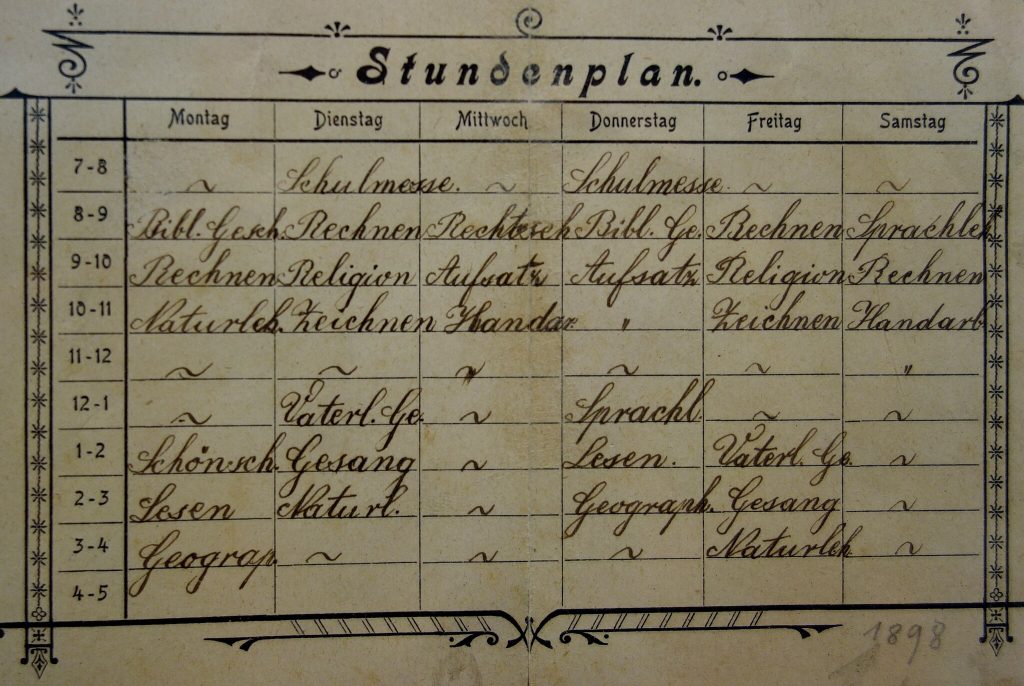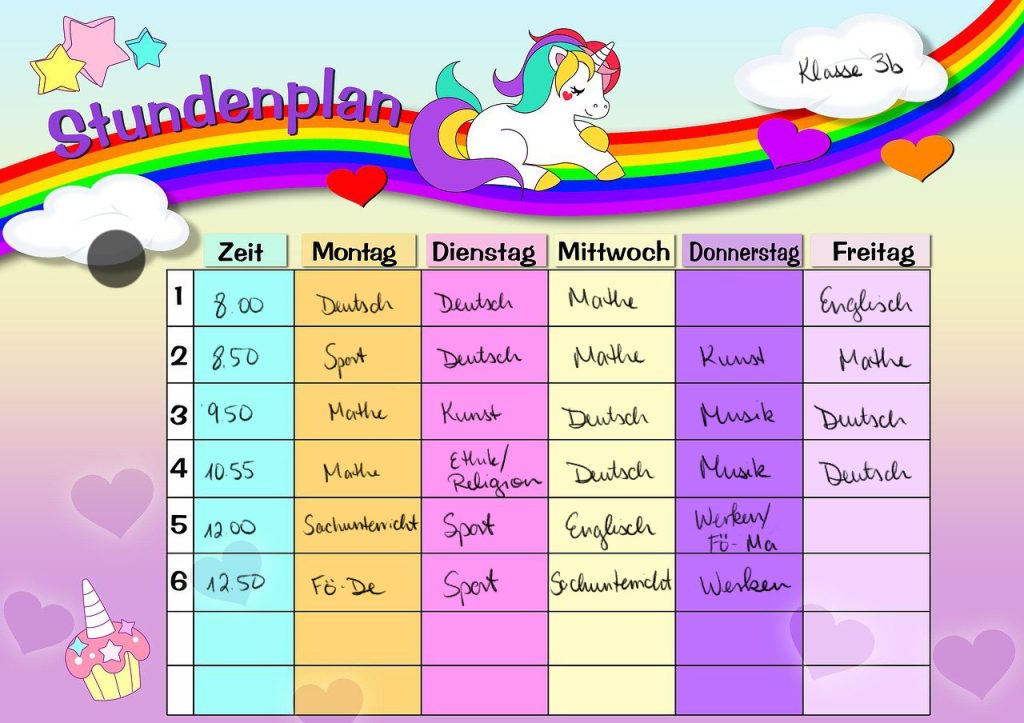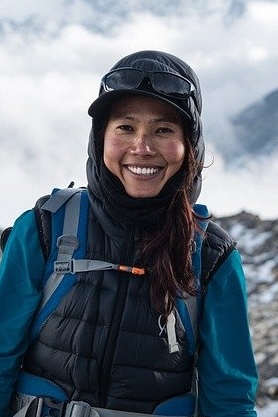4.2 Der Schultag

Lektionsüberblick
1. Gegenstände im Klassenzimmer
Jetzt bist du dran!
Was hast du jetzt in deinem Rucksack für die Uni? Answer the question in your written journal. To practice giving more detailed information, try using the structure from the last activity. If the object is not masculine or plural, like in that activity, you can practice using these forms:
Im Rucksack habe ich ein silbernes Lineal und eine neue Schere.
Was hattest du damals, als du ein Kind warst, in deiner Schultasche bzw. in deinem Rucksack? Now think about the kinds of things you had in your school bag, when you were a Schüler (pick any age!) and answer the question in your written journal. As a reminder, you will want to speak about these items in the past tense, for example:
Im Rucksack hatte ich damals viele schwere Schülbücher, ein blaues Mäppchen, 5 dicke Hefte und ein altes Tablet.
When you are done, check your spelling and structures again, then record your answers in your audio journal.
Lausanne im Blickpunkt

Lausanne ist die „Olympische Hauptstadt“, weil in dieser Stadt das Internationale Olympische Komitee seinen Hauptsitz hat. Deshalb ist Lausanne sehr wichtig für den weltweiten Sport. Außerdem gibt es dort das Olympische Museum, wo man viel über die Geschichte der Spiele lernen kann.
Lausanne is the “Olympic Capital” because the International Olympic Committee has its headquarters there. Therefore, Lausanne is very important for global sports. It also houses the Olympic Museum, where you can learn a lot about the history of the Games.
2. Die Schulfächer

Now that your backpack is packed, let’s look at your daily school schedule. What did yours look like? Did you have the same Fächer (subjects) every day? Did you have each Fach (subject) the same amount of time? Wie lange war dein Schultag? Did you have many Pausen (recesses/breaks)? To the left, you can see a Stundenplan from 1898 with some subjects you may recognize (Geographie, Religion, Zeichnen, Lesen) and others you may not. Guess the meaning of the other subjects! Can you guess for what kind of pupil this schedule would have been?
Now you will see more modern school schedules from Grundschule and from Gymnasium. How many of the Fächer can you identify immediately? What do you think the others can mean? Pay attention to the length of the school day and the Pausen.
Listen and read along with Lara Marti’s statements about her school days and her school schedule, first in the text and then in the dialogue cards. Flip the card over, if you do not recognize the subject.


Hallo! Ich heiße Lara Marti und ich komme aus Zürich. Hier ist mein Stundenplan von der 3. Klasse.
Als ich acht Jahre alt war, bin ich in die 3. Klasse gekommen. Ich war in der Klasse 3b. Die Parallelklassen waren 3a und 3c. Mein Klassenlehrer war Herr Engelbrecht.
Deutsch IRL und anderes
- Schulfächer, interactive video about school subjects
-
Schule: Nina und David gehen wieder zur Schule. Die beiden Moderatoren begleiten eine deutsche Schülerin und einen Schüler und fragen nach Lieblingsfächern, nehmen am Unterricht teil und essen in der Mensa. (Nina and David are going to school again. The two hosts accompany two German pupils and ask about their favorite subjects, participate in class, and eat in the cafeteria.)
Jetzt bist du dran!
Welche Fächer hattest du in der Grundschule? In der Mittelschule? In der High School? Wann hattest du sie? Was war dein Lieblingsfach? Wer war dein Klassenlehrer? Hattest du mal Förderunterricht? Answer the questions in your written journal, using the language modeled in this lesson. How many of the questions and how thoroughly you answer them depends on how much you would like to challenge yourself.
When you are done, check your spelling and structures. Then record your answers in your audio journal. As always, feel free to meet up with a classmate and record together.
3) Alternativschulen
The typical schools discussed in this and the previous lesson are called Regelschulen. Switzerland and the other German-speaking countries also have a variety of alternative schools, such as Waldorf schools and Lab Schools. You can read about each below (and listen to the audio) and then check your reading comprehension.
Waldorfschulen
Waldorfschulen sind alternative Schulen, die auf der Pädagogik von Rudolf Steiner basieren. Sie wurden 1919 in Stuttgart gegründet und haben sich seitdem weltweit verbreitet. In diesen Schulen wird großer Wert auf die ganzheitliche Entwicklung der Kinder gelegt. Der Unterricht umfasst kreative Fächer wie Malen, Musik und Handwerk, um die künstlerischen Fähigkeiten zu fördern. Zudem wird der Lehrplan an das Alter und die Entwicklungsstufen der Schüler angepasst, sodass sie in ihrem eigenen Tempo lernen können.Die Klassenräume sind oft bunt und einladend gestaltet, um eine positive Lernumgebung zu schaffen. Außerdem gibt es in Waldorfschulen keinen Druck durch standardisierte Tests, was den Schülern mehr Freiheit beim Lernen gibt. Waldorfschulen legen auch viel Wert auf Gemeinschaft und soziale Verantwortung. Viele Waldorfschulen haben auch einen starken Bezug zur Natur und integrieren viele Aktivitäten im Freien. Viele Eltern schätzen die individuelle Förderung ihrer Kinder und die entspannte Lernatmosphäre.
Laborschulen
Laborschulen sind spezielle Schulen, die experimentelle Ansätze in der Bildung verfolgen. Sie bieten einen Raum für innovative Lehrmethoden und fördern das eigenständige Lernen der Schüler. In Laborschulen steht die Praxis im Vordergrund, und die Schüler arbeiten oft an realen Projekten. Dies ermöglicht ihnen, ihr Wissen direkt anzuwenden und zu vertiefen.
Die Schüler haben in der Regel mehr Freiraum, um ihre Interessen zu verfolgen und eigene Themen zu wählen. Lehrkräfte agieren eher als Coaches, die die Lernenden unterstützen und anleiten. Laborschulen legen Wert auf Teamarbeit und Kooperation, wodurch die sozialen Fähigkeiten der Schüler gestärkt werden. Viele dieser Schulen setzen auch auf interdisziplinäres Lernen, bei dem verschiedene Fächer miteinander verknüpft werden.
Deutsch IRL und anderes
- Rudolf Steiner Schulen: Website for Rudolf Steiner schools in Switzerland
- Wer war Rudolf Steiner? (1hr4m)
- Liechtensteinische Waldorfschule: series of videos
- Erwecken von Kreativität und Phantasie im Kind (7m): video from Rudolf Steiner schools in Switzerland
- Waldorfschule Klagenfurt, Rudolf Steiners Waldorfpädagogik in Österreich (22m)
- Waldorfschule – Was ist das und für wen ist diese Schulform geeignet? (16m)
- Alternative Schulen in Deutschland: Text and audio about alternative schooling in Germany
- Alternative Bildungskonzepte – Labore für die Schule der Zukunft: Text about Lab Schools in Germany
Jetzt kombinieren!
In this lesson, you learned about 1) what you have and had in your school bag, 2) what subjects you had, and 3) you will be able to recognize some alternative kinds of schools. Now it’s time to combine your knowledge!
Der Schultag hier und dort: Think about what you’ve learned about elementary and secondary education in Switzerland and other German-speaking countries. What similarities and differences do you see? Using the language modeled in these lessons, write out you thoughts about what you have learned.

Media Attributions
- 2030-2040 ch banner reduced size
- Photo of Internationale Olympische Komitee by hjalmarGD, Flickr, CC BY-SA 2.0.
- 4.2 stundenplan 1898_2048px-Stundenplan_1898 © Mabit1 is licensed under a CC BY-SA (Attribution ShareAlike) license
- 4.2 stundenplan einhorn timetable-3219937_1280
- 4.2 person with mountains in background hiking-8216486_1280

